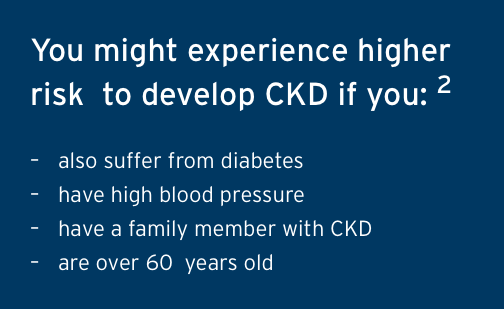It is estimated that 8 to 16% of the population worldwide suffer from CKD.
What is chronic kidney disease?
Chronic kidney disease (CKD), also known as chronic renal disease, is a condition that occurs when your kidneys don’t work as well as they should to excrete waste, toxins and excess fluid from your body.
CKD is characterised by a progressive loss of kidney function over time.
The end stage kidney disease (ESKD), end stage renal disease (ESRD) or kidney failure, may develop over many years or within only a few months. At this stage, you will require either dialysis or a kidney transplant.
Causes of CKD
Kidney disease is usually caused by other pre-existing health problems, which put pressure on the kidneys. Commonly, it is a combination of different health problems.
CKD becomes more common with increasing age (> 60 years with variations worldwide). Although older people are more likely to suffer from chronic kidney disease, it can be developed at any age.1
------------------------------------------------
Sources
1 https://www.kidney.org/news/monthly/wkd_aging (accessed 20.01.2021)
2 https://www.kidneyfund.org/prevention/are-you-at-risk/ (accessed 20.01.2021)

Stages of CKD
Defined by the level of the kidney function (glomerular filtration rate, GFR), there are five stages of chronic kidney disease. G 1 (GFR >= 90 ml/min/1.73 m2) is the earliest stage, while G 5 (GFR < 15 ml/min/1.73 m2) represents kidney failure. This stage is also called end-stage kidney disease (ESKD) or end-stage renal disease (ESRD). At this point, you have only about 10-15% of your kidney function left and a renal replacement therapy such as dialysis might be necessary for survival.1
By definition CKD starts at a eGFR <60ml/min/1.73m2 - G 3. Most patients may not have any severe symptoms until their kidney disease is advanced.2 Endocrine/ metabolic derangements or disturbances in the water or electrolyte balance become visible only in later stages (G4+: GFR <30 ml/min/1.73 m2).
CKD stages

------------------------------------------------
Sources
1 National Kidney Foundation https://www.kidney.org/atoz/content/hemodialysis (accessed 04.01.2021)
2 National Kidney Foundation www.kidney.org/atoz/content/about-chronic-kidney-disease (accessed 03.12.2020)
The Symptoms of CKD
Most kidney diseases attack the nephrons, causing them to lose their filtering capacity (= loss of GFR). Damage to the nephrons may sometimes happen quickly, for example as the result of an injury, poisoning or inflammation. But most kidney diseases destroy the nephrons slowly and silently (chronic kidney disease). Only after years or even decades, the damage becomes apparent.
Since at early stage patients may not suffer from any symptoms
often CKD is discovered via a routine blood and urine testing.
What are the signs of chronic kidney disease
In earlier stages of chronic kidney disease, there may be no symptoms at all and patients do not feel ill or the symptoms are very vague like1
-
Feel more tired and have less energy
-
Have trouble concentrating
-
Have a poor appetite
-
Have trouble sleeping
-
Have muscle cramping at night
-
Have swollen feet and ankles
-
Have puffiness around your eyes, especially in the morning
-
Have dry, itchy skin
-
Need to urinate more often, especially at night
------------------------------------------------
Sources
1 National Kidney Foundation www.kidney.org/atoz/content/about-chronic-kidney-disease (accessed 03.12.2020)
In later stages, and particularly in end-stage kidney disease, the following symptoms may occur or get worse:2
-
Weight loss and poor appetite
-
Swollen ankles, feet or hands
-
Shortness-of-breath/tiredness
-
Blood in urine
-
Increased need to pee – particularly at night
-
Difficulty sleeping/insomnia
-
Dry/itchy skin
-
Muscle cramps
-
Feeling sick
-
Headaches
------------------------------------------------
Sources
2 https://www.nhs.uk/conditions/kidney-disease/symptoms/ (accessed 18.12.2020)
Track your course of life
This diary is a space for your plans, thoughts, ideas and moods about your journey with CKD. Designed to begin at any date you can find in the download a planner covering 1 month: with 4 weekly pages and a summary page to reflect over the past month. You can print or copy them each month newly and thereby create your own ongoing personal diary to oversee your appointments and personal goals with ease. It is supposed to help you reflect on your physical and emotional well-being, identify thing that lift you up or pull you down and stay on top of your diet.

Diagnosis
Since a person can have kidney disease without any symptoms, your doctor may initially detect the condition through routine blood and urine tests. Testing is the only way to know if you have CKD.
Urine test
A urine test is one type done to check the levels of substances called albumin and creatinine in your urine – they are put in relationship and expressed as the Albumin to Creatinine ratio, or ACR.
Proteins (albumin is of blood protein) usually do not appear in the urine and are therefore a marker of kidney damage. If this test is repeatedly “positive” for protein over a period of three months or more, it is a sign of kidney disease.
Blood test
The main test for kidney disease is a blood test. The test measures the levels of creatinine in your blood. Your physician uses your blood test results, plus other parameters like your age, size, gender and other factors to calculate how many millilitres of fluid your kidneys are able to filter in a minute.
This calculation is known as your estimated glomerular filtration rate (eGFR) and done through validated formulas.
Creatinine is a breakdown product of muscle cells. If a certain level of kidney disease is reached the blood creatinine levels correlates with kidney function.
In the lab, your blood will be tested to see how many milligrams of creatinine are in one deciliter of blood (mg/dl). Creatinine levels in the blood can vary, and each laboratory has its own normal range, usually 0.7 to 1.3 mg/dl (61.9–115 µ mol/L).1 If your creatinine level is only slightly above this range, you probably will not feel unwell, but the elevation might be a sign that your kidneys are not working at full capacity.
Check your eGFR Value
Further diagnostics
Once CKD is identified, your doctor will try to find the underlying cause of the disease. This is important, since treating the cause can help to slow the progression of chronic kidney disease.
There are many different diagnostic techniques that can be used, for example imaging techniques (ultrasound, computed tomography, magnetic resonance imaging) and several different kinds of blood tests. In some cases, it may be necessary to perform a biopsy, i.e. to remove a tiny piece of the kidney to examine it under a microscope and see how much kidney damage has occurred.1
------------------------------------------------
Sources
1 https://www.kidney.org/atoz/content/about-chronic-kidney-
disease (Accessed 04.01.2021)



